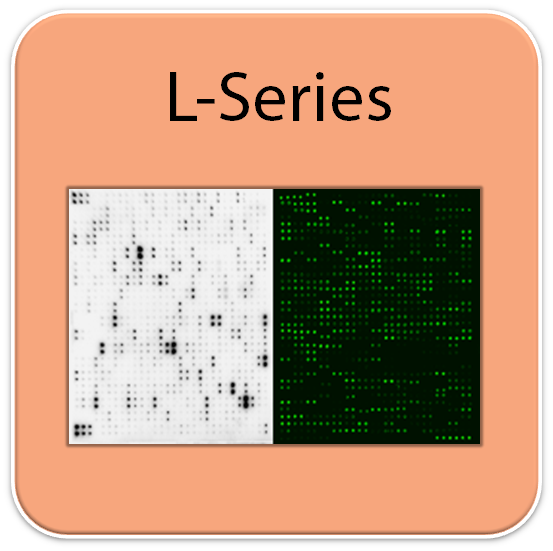Product Features
- High density arrays
- Unbiased detection through direct biotin labeling of samples
- Low sample consumption
- High detection sensitivity
- Same day result
- Affordable and simple to use
Target Names
AARE, ACAT1, acyl-CoA Thioesterase 2, ADAM28, AHCY, AK1, AKR1A1, ALDH2, alpha 5 D, ANKRD9, Annexin A3, AP180, AP3S2, APLP2, Apolipoprotein A V, ASPM, ASS1, ATOX1, ATPG, AUTS2, BAI2, BarX1, BBS1, BE2I / UBC9, BLM, BOLA2, C10orf58, CACNA1H, Calpain 2, CaMK2, CaMK2D, CBL, CBR1, CCDC58, CCT6A, CHCHD3, Cingulin, CIT, CMG1, CNBP, CNPY2, Coilin, COL8A2, COLEC11, COPG2, CORO1B, CPA3, CPI17 alpha, CrkRS, CRLF3, CSRP3, CTNNAL1, CTNND1, Cyclophilin F, Cytochrome b5, DCAMKL1, Dematin, DIAPH1, DKC1, DLST, DMRT1, Dystrophin, Ebf4, EBP50, ECHDC1, EHHADH, EIF3D, eIF4A2, eIF4GII, ENDOD1, EYA2, Factor VIII, Filaggrin, FITM1, GARS, GCC2, GLI-2, GLOD4, GLUL, GMPR1, GOLGA3, GP2, gp340, GTF2F1, HA1, HARS, HIC1, HIP55, Histone H1.0, Histone H1.5, HIVEP2, hnRNP K, hnRNP R, HNRNPUL2, HNRPA3, HP1 g, IGSF4A, Importin 7, Involucrin, ISLR, ITPR2, ITPR3, KCNAB3, Laminin alpha 5, LDB3, LHPP, LIPG, MAP4K4, MICALL2, MON2, MPST, MRC2, MSH3, MTA2, MTHFD1, MUC5B, MVD, Myosin IIB, NACA1, NAGPA, NAV2, Nectin-4, NFATC4, NNT, NPEPPS, NQO2, NSFL1C, Nucleobindin 1, NUP214, OAF, OIT3, Oncostatin M R beta, OPCML, Orosomucoid 2, OSBP1, OSCAR, Osteoadherin, OTC, OTUB1, OTUD7A, Oxytocin-neurophysin 1, p16 ARC, p23, p39, P4HB, p73, PABP1, PACS1, Pancreatic Lipase, PARVB, PCAP, PCBP1, PCBP2, PCCA, PCDH8, PCK2, PCMT1, PCNA, PCPE-1, PDAP1, PDE1B, PDIA6, PDLIM1, PDLIM3, PDZD2, PEBP1, PEBP4, PENK, PEPD, perilipin 3, Perilipin-1, Periostin, Periplakin, Peroxiredoxin 2, Peroxiredoxin 3, Peroxiredoxin-1, PFAS, PFDN6, PFKL, PGAM1, PGAM2, PGK-1, PGLS, PG-M, PGM1, PGRPL, PHGDH, Piccolo, pIgR, PIK3C2B, PIN, PIP5K2 alpha, PISD, PLA2G1B, Plastin 3, Plastin L, PLBD2, PLD4, Plectin, Plexin B1, Plexin B2, PLOD1, PLOD2, Plxdc2, PMCA, PNP, POLD2, POLR2A, POR, PPOX, PPP1CC, PPP1R9A, PPP2R1B, PPP2R4, PRCP, PRDM13, PREP, PRG2, Prion protein PrP, Profilin 1, Prolargin, Proprotein Convertase 9, Prosaposin, Prostaglandin D Synthase, Proteasome 26S S2, Protein C, Protein Z, Protocadherin-12, PRRC2A, PRSS23, PRSS3, PRTN3, PSMA1, PSMA2, PSMA4, PSMA5, PSMA6, PSMB1, PSMB2, PSMB3, PSMB4, PSMB5, PSMB6, PSMB7, PSMC3, PSMD1, PSMD5, PSMD9, PSME1, PSME2, PTBP1, PTEN, PTGR1, PTK 7, PTMA, PTPRG, PTPRK, PTPRM, PTPRZ, PZP, QARS, QDPR, QPRT, Quiescin Q6, Rab1A, Rab7a, Ran, RanBP1, RanGAP1, RAP1B, Rbm15, RCL, RECQ4, Reg3A, REV3L, RHOC, RHOG, Ribonuclease A, Ribonuclease T2, RLF, RNASE4, Rnose2, RP1, RPL10, RPL10A, RPL11, RPL12, RPL14, RPL17, RPL22, RPL23A, RPL3, RPL32, RPL4, RPL7, RPL7A, RPLP0, RPLP2, RPS10, RPS11, RPS12, RPS13, RPS14, RPS15A, RPS16, RPS18, RPS19, RPS2, RPS20, RPS23, RPS25, RPS3, RPS3A, RPS4X, RPS5, RPS8, RPS9, RREB1, RSF1, RSU1, RUSC1, S E P T 7, S100 A1, S100A11, S100A7, S100A9, SAA, SAA4, SBP-1, SC35, SCG, SCN3A, SCP2, SDNSF, SDPR, SECISBP2, Secretogranin V, Semaphorin 6B, Semaphorin 7A, SERBP1, Serpin A11, Serpin A7, Serpin B3D, Serpin B6, Serpin B8, Serpin F2, Serpin H1, Serpina10, SERPINB1, SerpinB4, SerpinE2, SerRS, SET, SEZ6L2, SF20, SHANK1, SHC1, SHMT1, SHOX, SHP-1, Siglec-1, SIM2, SIRPB1 , Six3, SLC4A1, SLITRK1, SLURP1, SMAD6, SMC4, SMPD4, SNRPD1, SOD1, SOD2, SOD-3, Somatoliberin, Somatostatin, SORD, SorLA, SOX4, SOX5, SP-D, Spectrin, SPEN, SPG48, SPINK5, SPS2L, SPTBN2, SPTLC1, Src, SSC5D, STAT3, Stathmin 1, STI1, STOM, STXBP2, SUCLG1, SUMO3, SVEP1, Symplekin, Synemin, SYNPO2L, Syntaxin 7, TAB182, Talin1, TARS, TAX1BP3, TBCA, TCEB2, Tcf20, TCP1 delta, TCP1 eta, TCP1 theta, TCTP, TDIF2, Tenascin C, Tenascin XB, TFF2, TGM3, Thimet Oligopeptidase, Thioredoxin-1, TIF1 alpha, TMEM103, TOB2, TOMM70A, TOP2B, TPD52L2, TPM4, TPP1, TPPP3, TPR, Transaldolase 1/TALDO1, Transthyretin, TRAP1, TRAP220, TRF 2, TRIM14, Tropomyosin 3, TRP-1, TRPS1, Trypsinogeb-2, TSR2, TTC3, TTF1, TUBA6, TWF2, TXNDC15, TXNDC4, TXNDC5, TXNRD2, UBA1, UBE2D3, Ube2L3, UBE2N/Ubc13, UCH-L1, UFM 1, UGGT, UMP/CMP, UNC13 Homolog D, UNC45A, UNC5H4, UPB1, UQCRB, UQCRH, URB, URB2, UROC1, UROD, Uroguanylin, URP2, USP14, USP2, USP5, Uteroglobin, Utrophin, valyl tRNA, VAP-1, VAP-A, VCP, VDAC1, VILIP3, Vimentin, VNN1, VPS4B, VSIG4, WDR1, WDR44, WISP2, WNK2, XPG, YB1, YN1 / Synapsin 1, YY1, ZAK, zbtb11, ZBTB4, ZC3H18, ZC3H4-N-t, ZC3H8, ZNF295, Zyxin
Application Notes
Suggested Application
Multiplexed Protein Detection; Detection of Relative Protein Expression; Detecting Patterns of Cytokine Expression; Biomarker Screening; Identifying Key Factors; Confirming a Biological Process; Cross-species testing
Kit Components
- RayBio® L-Series Antibody Array Glass Slide(s)
- Spin Columns
- Labeling Reagent
- Stop Solution
- Blocking Buffer
- Wash Buffer 1
- Wash Buffer 2
- Streptavidin-Conjugated Fluor
- Adhesive Plastic Strips
- Labeling Buffer
- Lysis Buffer
- 30 ml Centrifuge Tube
Other Materials Required
- Distilled or de-ionized water
- Small plastic or glass containers
- Orbital shaker or oscillating rocker
- 1 ml tube
- Pipettors, pipette tips and other common lab consumables
- Aluminum foil
- Gene microarray scanner or similar laser fluorescence scanner
View Compatible Laser Scanners
Don't have a compatible scanner? RayBiotech now offers FREE scanning service for all RayBio glass slide antibody arrays! Learn More
Protocol Outline
- Purify Samples with Spin Column
- Biotinylate Samples
- Purify biotinylated samples using spin column
- Dry the glass slide
- Block array surface
- Incubate with Samples
- Incubate with Streptavidin-Conjugated Fluor
- Disassemble the glass slide
- Scan with a gene microarray laser scanner
- Perform densitometry and analysis
Storage/Stability
For best results, store the entire kit frozen at -20°C upon arrival. Stored frozen, the kit will be stable for at least 6 months which is the duration of the product warranty period. Once thawed, store array slide(s) at -20°C and all other reagents undiluted at 4°C for no more than 3 months.


